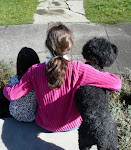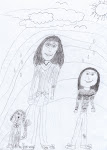First, an apology. I am woefully overdue in posting here at Pack of Three. The good news is that all is well with our happy pack. In fact, as much as the past school year had its challenges, the summer seems to have delivered -- in direct opposition and proportion to the school year -- more than its share of joys. My daughter's favorite t-shirt and personal motto these days? Life is Good.

I have to concur. I'm not immune to a hormonal moment or two, but the truth is, its all too easy to forget and take for granted just how blessed we are.
Until the school year is well underway (and mom makes more progress on the job front,) I won't have a lot of time for blog posts. Nevertheless, I had to check in and share a link to a wonderfully insightful, honest, thought-provoking article written by Martha Nichols, published this summer in BRAIN, CHILD: "What's My Heritage: International Adoptions and the Culture Debate."
Martha and her husband adopted their son Nicholas from Vietnam in 2003. She writes about Nicholas' ambivalence toward his birth country and culture and, more specifically, writes about her own struggle to find the right balance in helping acquaint her son (and family) with Nicholas' birth country and culture, addressing thorny issues of race and identity.
How much should we do as parents? How far do you take it -- or push it?
It's a balancing act most parents of internationally adopted children struggle with. We know, based on the overwhelming evidence shared by previous generations of Korean-American adoptees, that we ignore these questions of race and culture at our child's peril. But Nichols raises another interesting question: Has the current generation of parents of internationally adopted children really figured out the best or healthiest way to address these issues? The options -- and pitfalls -- are many.
Some families purchase cheese-y costumes and trinkets. Others enroll their children in a myriad of dance classes, language classes, craft classes, caligraphy classes, even martial arts classes. Others drop in once a year for a token New Year's or other celebration. These efforts are all made in earnest. But Nichols asks the uncomfortable question if culture is really a matter of consuming a couple of commercial pre-packaged trinkets, if its a series of classes, a one-time event, or an annual weekend retreat.
How many of us reach for these things as quick, easy answers so, in busy, overscheduled lives, we can assuage a guilty conscience and check off the "culture" box? Nichols calls it "Culture-lite."
My guess is most adoptive parents sense, like Nichols, that culture and identity tend to be something both more subtle -- and more elusive, something that's woven into everyday life. It's the language we speak, the foods we eat, the faces we see, the little day in and day out, or seasonal, rituals.
So how do we as parents capture something as elusive as this and make it accessible to our children, especially when that second culture may be as foreign to us as it is to our children?
Nichols acknowledges that an imperfect effort is far better than no effort. And then, its important to look for those opportunities to make that culture -- in one form or another -- a more natural part of everyday life. Beyond that, for every child, for every family, the answers will be different. In the end, as parents, its our job to try and help our children bridge the gap and navigate a story that produces that mixed sense of identity and belonging.
At the very least, it takes a lot of listening, a lot of loving, along with a willingness to stretch beyond our normal comfort zone.
Nichols does a wonderful, thoughtful job exploring these issues.





